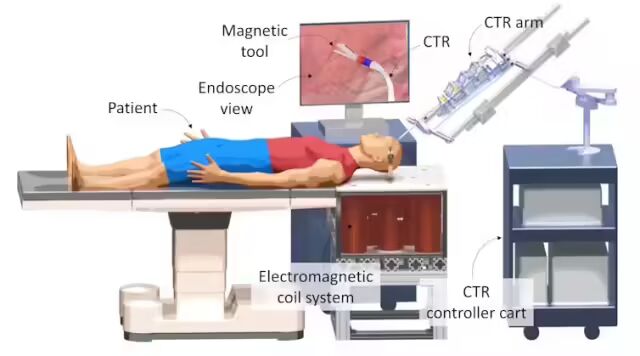Introduction
Related research paper published in the recent issue of “Science Robotics”.
In traditional brain surgeries, doctors often need to remove a portion of the skull to access hard-to-reach areas of the brain or tumors. This surgical method is highly invasive, carries significant risks, and results in long recovery times for patients. However, a new technological breakthrough promises to change this situation dramatically.

Led by the University of Toronto in collaboration with the Hospital for Sick Children (SickKids), the research project has successfully developed a micro neurosurgical tool with a diameter of only about 3 millimeters, capable of simulating the dexterous movements of surgeons, allowing for precise gripping, pulling, and cutting of body tissues, thus providing a new tool for less invasive brain surgeries. The related research paper was published in the recent issue of “Science Robotics”.
According to IT Home, robotic surgical tools with a diameter of about 8 millimeters have been widely used in minimally invasive surgeries on other parts of the human body over the past few decades. However,reducing the tool size to a suitable 3 millimeter diameter for neurosurgery has been a technical bottleneck in this field.
The newly developed micro tool achieves this breakthrough by being driven by an external magnetic field rather than traditional motors. Conventional robotic surgical tools rely on cables connected to motors, operating similarly to human fingers, controlled by muscles and tendons in the wrist and hand. However, when attempting to reduce the tool size to a few millimeters, this design faces numerous challenges, such as insufficient strength of small pulleys, friction, stretching, and breakage, making miniaturization extremely difficult.
The new robotic surgical system consists of two parts: one is the micro surgical tool, which includes a gripper, surgical knife, and tweezers; the other is the “coil surgical table,” which embeds multiple electromagnetic coils into the surgical table.
During the surgery, the patient’s head will be placed on the surgical table embedded with coils, and the micro tool will be inserted into the brain through a small incision. By adjusting the current in the coils, the surgeon can precisely control the magnetic field, enabling the tool to grasp, pull, or cut tissue.

In traditional craniotomies, surgeons rely on their flexible wrists to rotate tools and tilt their tips to access deep areas of the brain, such as removing tumors from the central cavity of the brain. This new type of robotic neurosurgical tool can simulate this operation through “wrist” movements, demonstrating remarkable flexibility and precision.
In preclinical trials, researchers simulated the mechanical properties of brain tissue using materials like tofu and raspberries placed in a brain model for testing. The experimental results showed thatthe magnetic-controlled surgical knife produced consistent and narrow incisions, with an average width of only 0.3-0.4 millimeters, which is more precise than the incisions made by traditional manual tools (ranging from 0.6 to 2.1 millimeters).
The success rate of the gripper in grasping was also achieved at 76%.
Despite the excellent performance of the micro robotic surgical tool in experiments, applying it clinically still requires a lengthy process. Developing medical devices, especially surgical robots, often takes years or even decades.
This research is part of a long-term project led by Professor Eric Diller of the University of Toronto, an expert in the field of magnetically driven micro robots. Currently, the research team is working to ensure that the robotic arm and magnetic control system can be comfortably installed in hospital operating rooms and made compatible with imaging systems such as fluoroscopy, which uses X-rays for imaging. Only after completing these steps can these tools hope to enter the clinical trial phase.






Disclaimer
Article source: IT Home
Any information sourced from other media is reprinted from other media and does not represent our website’s endorsement of its views, nor does it represent our website’s responsibility for its authenticity. For reprints and business cooperation, please contact Teacher Mu at 159 0176 7989 (WeChat same number).